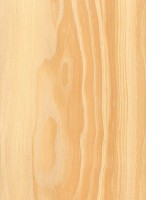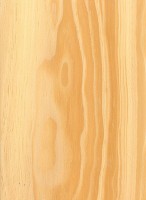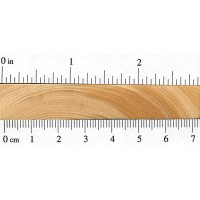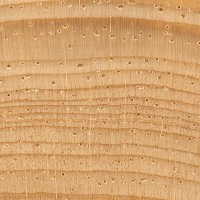 |
Common Name(s): Pinyon Pine, Two-needle Pinyon, Colorado Pinyon Scientific Name: Pinus edulis Distribution: Southwestern United States and northwestern Mexico Tree Size: 30-50 ft (9-15 m) tall, 1-2 ft (.3-.6 m) trunk diameter Average Dried Weight: 37 lbs/ft3 (595 kg/m3) Specific Gravity (Basic, 12% MC): .50, .59 Janka Hardness: 860 lbf (3,830 N) Modulus of Rupture: 7,800 lbf/in2 (53.8 MPa) Elastic Modulus: 1,140,000 lbf/in2 (7.86 GPa) Crushing Strength: 6,400 lbf/in2 (44.1 MPa) Shrinkage: Radial: 4.6%, Tangential: 5.2%, Volumetric: 9.9%, T/R Ratio: 1.1 |
Color/Appearance: Heartwood is a yellowish brown. Due to its tpically short, stout trunk, knots and other grain irregularities are common.
Grain/Texture: Grain can be irregular and full of knots, with a medium to fine texture.
Endgrain: Large resin canals, numerous and evenly distributed, mostly solitary; earlywood to latewood transition relatively gradual, color contrast low to moderate; tracheid diameter small to medium.
Rot Resistance: Since Pinyon Pine isn’t generally harvested as lumber, no known durability tests are available; however, a study done on standing dead trees indicates mediocre durability for the species.
Workability: No data available.
Odor: Pinyon Pine has a resinous odor when being worked. Pinyon Pine is also known for its distinctive fragrance when burned as firewood.
Allergies/Toxicity: Working with pine has been reported to cause allergic skin reactions and/or asthma-like symptoms in some people. See the articles Wood Allergies and Toxicity and Wood Dust Safety for more information.
Pricing/Availability: Because of their small size and short trunks, Pinyon Pines aren’t harvested for lumber commercially. Availability is likely to be limited to specialty/hobbyist projects within the tree’s natural range.
Sustainability: This wood species is not listed in the CITES Appendices, and is reported by the IUCN as being a species of least concern.
Common Uses: Firewood, paper (pulpwood), charcoal, and utility lumber.
Comments: The Pinyon Pine is a very slow-growing pine that is adapted to drier climates. Because of its diminutive form, it’s seldom harvested for lumber, but the tree does yield large edible seeds known as pine nuts that are used in cooking.
Pinyon Pine is sometimes spelled/referred to simply as Piñon, and is the state tree of New Mexico.
- Austrian Pine (Pinus nigra)
- Caribbean Pine (Pinus caribaea)
- Eastern White Pine (Pinus strobus)
- Jack Pine (Pinus banksiana)
- Jeffrey Pine (Pinus jeffreyi)
- Khasi Pine (Pinus kesiya)
- Limber Pine (Pinus flexilis)
- Loblolly Pine (Pinus taeda)
- Lodgepole Pine (Pinus contorta)
- Longleaf Pine (Pinus palustris)
- Maritime Pine (Pinus pinaster)
- Ocote Pine (Pinus oocarpa)
- Patula Pine (Pinus patula)
- Pitch Pine (Pinus rigida)
- Pond Pine (Pinus serotina)
- Ponderosa Pine (Pinus ponderosa)
- Radiata Pine (Pinus radiata)
- Red Pine (Pinus resinosa)
- Sand Pine (Pinus clausa)
- Scots Pine (Pinus sylvestris)
- Shortleaf Pine (Pinus echinata)
- Slash Pine (Pinus elliottii)
- Spruce Pine (Pinus glabra)
- Sugar Pine (Pinus lambertiana)
- Sumatran Pine (Pinus merkusii)
- Table Mountain Pine (Pinus pungens)
- Western White Pine (Pinus monticola)
- Virginia Pine (Pinus virginiana)




